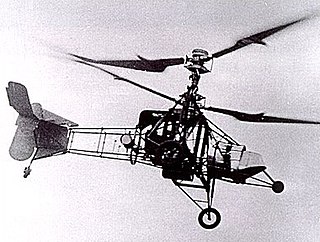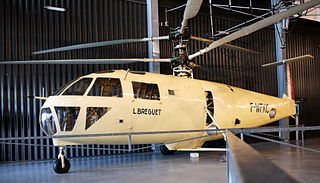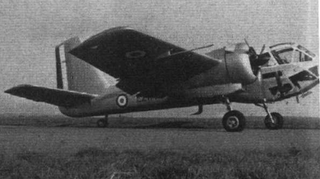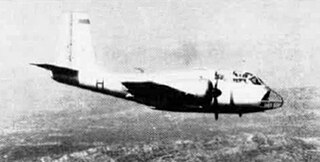Related Research Articles

SNCASE or Sud-Est was a French aircraft manufacturer. The company was formed on February 1, 1937, by the nationalization and merger of Lioré et Olivier, Potez, CAMS, Romano and SPCA.

Hanriot H.230 was a French twin-engined advanced trainer. The construction of the aircraft was initiated in 1936 by Hanriot's chief designer Montlaur. The aircraft was produced by the nationalized factory SNCAC.

The Gyroplane Laboratoire was an early helicopter. Its designer, Frenchman Louis Bréguet, had already experimented with rotorcraft in 1909; however, he chose to concentrate on airplanes until the end of the 1920s. In 1929 he announced a set of patents which addressed the flight stabilization of rotorcraft, and, in 1931, Bréguet created the Syndicat d'Etudes de Gyroplane, together with Rene Dorand as technical director. Their goal was the development of an experimental helicopter, the Gyroplane Laboratoire.
The SNCASE SE.3120 Alouette ("Lark") was a utility helicopter developed in France in the early 1950s but which did not enter production. Designed in parallel with the SE.3110, the Alouette shared that machine's dynamic components, with the exception of its unusual twin tail rotor. The Alouette featured an open-framework fuselage behind a cockpit that was enclosed by a bubble canopy. Skid undercarriage and tricycle gear were both tested.

The Flettner Fl 185 was an experimental German gyrodyne developed by Anton Flettner, a machine which could fly both as a helicopter and as a gyroplane.

The SNCASE SE.100 was a French two-seat, twin-engined fighter which first flew in 1939. Mass production was planned to begin late in 1940 but the Fall of France prevented this.
The SNCASE SE.3200 Frelon (Hornet) is a French helicopter built in the late 1950s. Intended to serve as a multirole helicopter for the French Army, Air Forces and Navy, two prototypes were built and flown before the project was dropped in favour of the SA 3210 Super Frelon.
The Farman F.30A C2 was a two-seat biplane designed as a fighter in France in 1916 and powered by a single, water-cooled radial engine. It showed poor flight characteristics and only one was built, though it was modified twice. It should not be confused with the similarly named Henry Farman HF.30 of 1915, a completely different aircraft which was used in large numbers by the Imperial Russian Air Service.

The SNCASE SE-3101 or Sud-Est SE-3101 was an early, experimental French helicopter with twin tail rotors. Only one was built.
The Barbaro RB-50 was a small, French, high wing single engine light aircraft, amateur built in the 1960s. Only one was completed.

The Bréguet G.111 or alternatively, G.11E was a French passenger coaxial rotors helicopter flown soon after World War II. Only one was built, development ceasing when funding ran out.

The SNCAC NC.2001 Abeille was a single engine, twin intermeshing rotor helicopter designed and built in France in the late 1940s. Three were completed but only one flew, development ending when SNCAC was closed.
The Nord 1700 Norélic or SNCAN N.1700 Norélic was a French helicopter with several novel control features. Only one prototype was built, though it was intended to lead to series production.

The SIPA S.1100 was a French twin engine observation and ground support aircraft flown in 1958. The first prototype was destroyed in a fatal crash only a few weeks after its first flight and no more were constructed.

The twin turboprop Sud Aviation SE-116 Voltigeur of the late 1950s was a French army support aircraft capable of observation and ground attack operations. Three were built but no series production was undertaken.
The SNCASE SE-700 was a three-seat passenger autogyro designed during World War II. Two were completed but only the first flew and the programme was soon abandoned.
The Piel CP-20 Pinocchio is a single engine French sport monoplane first flown in 1951. Only two were built but one was still flying over sixty years later.
The Piel CP-40 Donald is a French homebuilt, single engine, single seat, high wing aircraft. It was first flown in the early 1950s, though the last of the three examples completed did not fly until almost forty years later.

The Hirsch or Hirsch-MAéRC H.100 is an experimental aircraft, built in France in the 1950s to test an aerodynamic gust suppression system. The system worked but was not further developed.
René Mouille was a French engineer, and designer of many of France's most well-known and important helicopters, widely flown by many air forces around the world.
References
- ↑ Parmentier, Bruno. "SE-3110". aviafrance.com (in French). Retrieved 7 January 2015.
- 1 2 3 4 "Helicopter development in France". Flight . Vol. LVII, no. 2150. 9 March 1950. pp. 310–311.
- 1 2 3 Gaillard, Pierre (1990). Les Avions Francais de 1944 à 1964. Paris: Éditions EPA. p. 111. ISBN 2-85120-350-9.
- ↑ "Complete (Historical) Civil Rotorcraft Register of France (part 1)" . Retrieved 3 January 2015.
- ↑ "Ray Watkins collection: S.E.3110" . Retrieved 4 January 2015.
- ↑ Danial Liron. "Les hélicoptères français : de la SNCASE à Eurocopter" . Retrieved 3 January 2015.
- ↑ Gaillard (1990). Les Avions Francais de 1944 à 1964. p. 128.